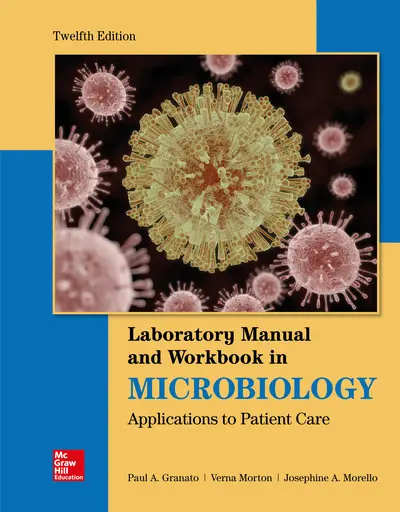My Account Details

ISBN10: 1260002187 | ISBN13: 9781260002188

* The estimated amount of time this product will be on the market is based on a number of factors, including faculty input to instructional design and the prior revision cycle and updates to academic research-which typically results in a revision cycle ranging from every two to four years for this product. Pricing subject to change at any time.
Instructor Information
Quick Actions (Only for Validated Instructor Accounts):
This lab manual emphasizes the basic principles of diagnostic microbiology for students preparing to enter the allied health field. Students are led through a series of exercises that allow them to learn basic microbiology techniques and practice safety in the laboratory and hospital environment. It is primarily oriented toward meeting the interests and needs of those who will be directly involved in patient care and wish to learn how microbiological principles should be applied in the practice of their professions.
The authors articulate the purposes and function of the clinical microbiology laboratory in the diagnosis of infectious diseases. Exercises illustrate the nature of laboratory procedures used for isolation and identification of infectious agents as well as the principles of asepsis, disinfection and sterilization. The role of the health professional is highlighted in regard to appropriate collection of clinical specimens and application of aseptic and disinfectant techniques as they relate to patient care.2. Handling and Examining Cultures
3. Simple Stains, Hanging Drop, and Wet-Mount Preparations
4. Gram Stain
5. Acid-Fast Stain
6. Culture Media
7. Streaking Technique to Obtain Pure Cultures
8. Subculture Techniques
9. Moist and Dry Heat
10. The Autoclave
11. Disinfectants
12. Antimicrobial Agent Susceptibility Testing and Resistance
13. Primary Media for Isolation of Microorganisms
14. Some Metabolic Activities of Bacteria
15. Activities of Bacterial Enzymes
16. Antigen Immunoassays for Detection and Identification of Microogranisms
17. Principles of Nucleic Acid Assays for Multiplex Syndrome Panel Testing for the Diagnosis of Infectious Disease
18. Principles and Applications of MALDI-TOF Mass Spectrometry for the Rapid Identification of Bacteria and Fungi
19. Streptococci
20. Streptococci, Pneumococci, and Enterococci
21. Haemophilus, Corynebacteria, and Bordetella
22. Clinical Specimens from the Respiratory Tract
23. The Enterobacteriaceae (Enteric Bacilli) and Other Clinically Important Gram-Negative Bacilli
24. Clinical Specimens from the Intestinal Tract
25. Urine Culture Techniques
26. Neisseria and Spirochetes
27. Clinical Specimens from Blood
28. Anaerobic Bacteria
29. Mycobacteria
30. Mycoplasmas, Rickettsiae, Chlamydiae, Viruses, and Prions
31. Fungi:Yeasts and Molds
32. Protozoa and Animal Parasites
33. Serodiagnosis of Infectious Disease
34. Principles and Practices of Infection Prevention
Need support? We're here to help - Get real-world support and resources every step of the way.